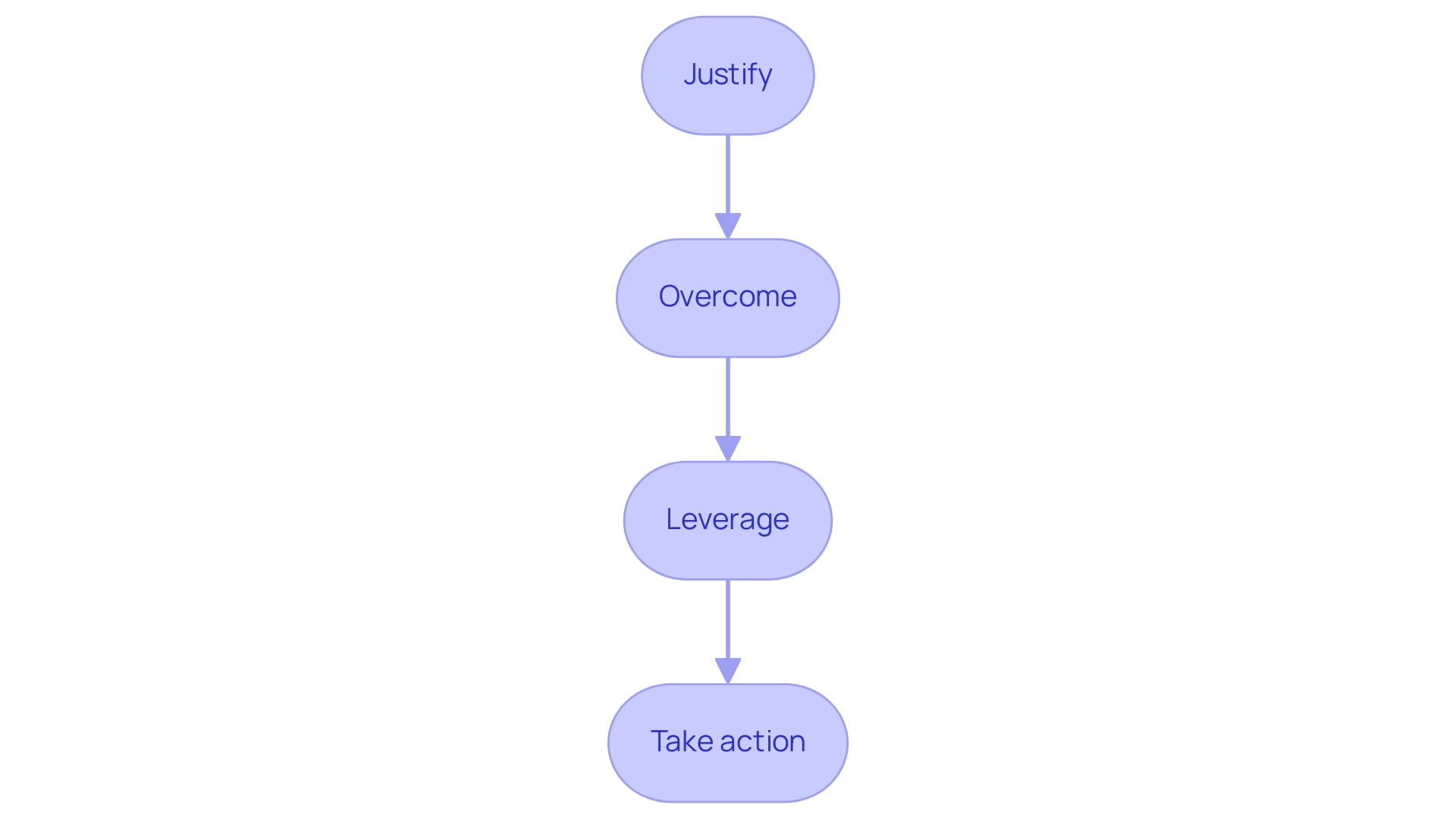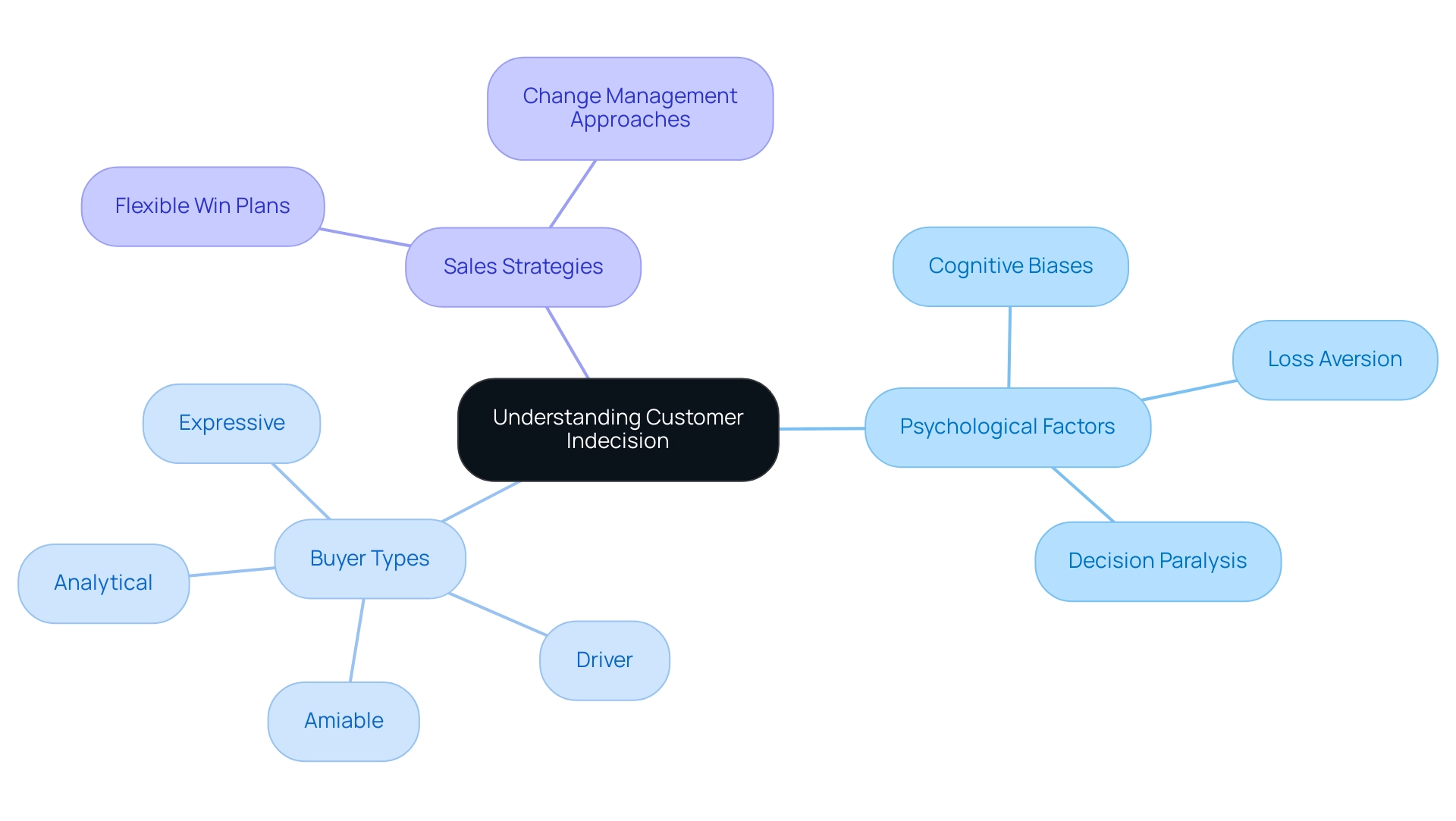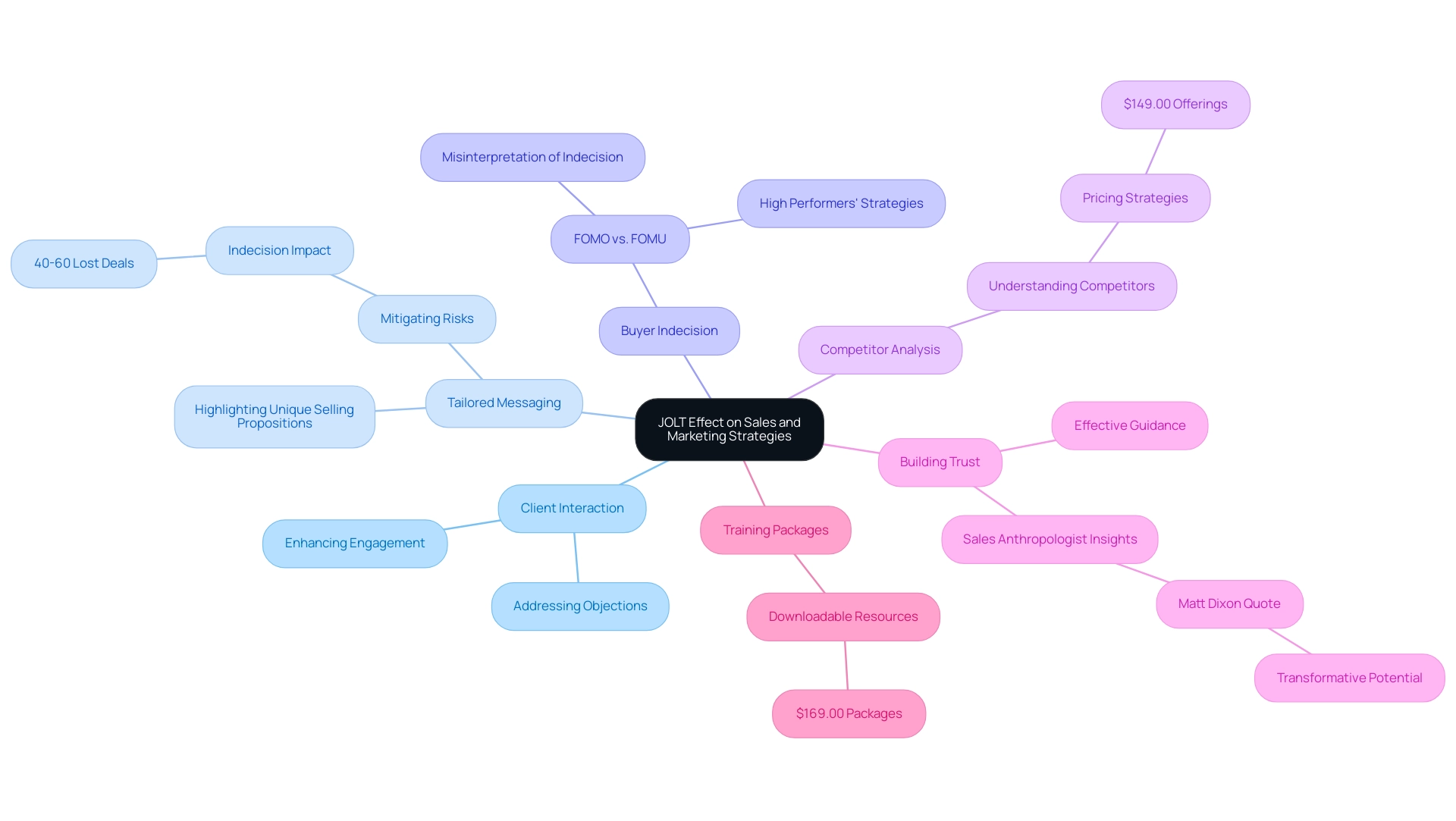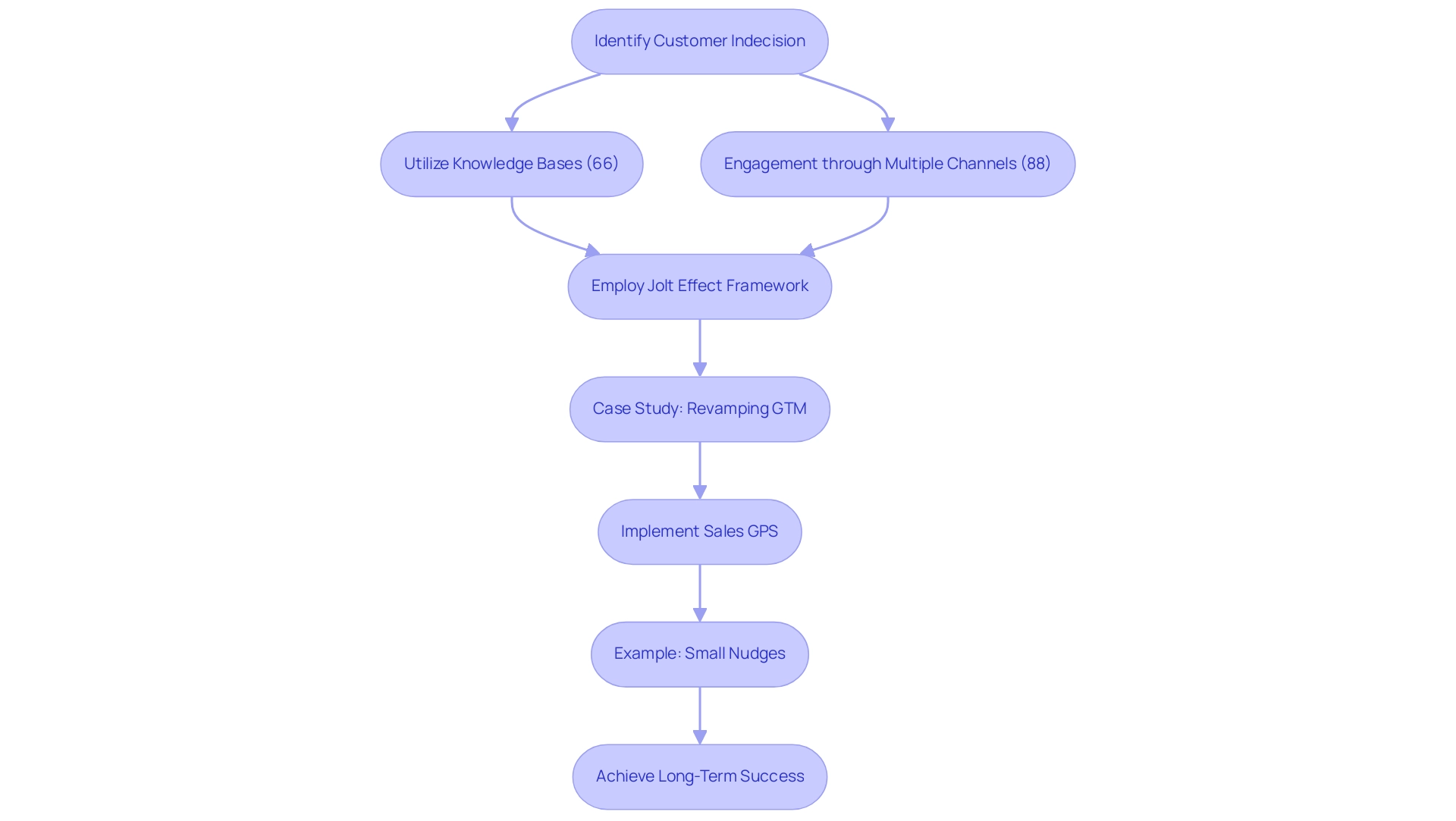
The JOLT effect is a framework designed to help businesses overcome customer indecision by providing structured strategies that include Justifying, Overcoming objections, Leveraging insights, and Taking action. The article emphasizes that by effectively applying these strategies—such as articulating unique value propositions and addressing buyer concerns—businesses can significantly enhance customer engagement and conversion rates, ultimately driving sales efficiency and fostering sustainable growth.
In an increasingly complex marketplace, customer indecision poses a significant barrier to sales success. The JOLT Effect emerges as a vital framework designed to help sales professionals navigate this challenge by addressing the root causes of indecision.
By focusing on the principles of:
sales teams can develop targeted strategies that not only clarify value propositions but also build trust and encourage decisive actions from potential buyers.
This article delves into the intricacies of the JOLT Effect, exploring its application in sales and marketing strategies, the psychological factors influencing customer choices, and the transformative impact it can have on business outcomes.
As organizations strive to adapt to evolving consumer expectations and competitive pressures, mastering the JOLT Effect is essential for driving sustainable growth and enhancing customer engagement.
The jolt effect serves as a critical framework for professionals aiming to mitigate customer indecision, which can significantly impede outcomes. The acronym stands for Justify, Overcome, Leverage, and Take action, each element playing a vital role in guiding business strategies. Sales representatives must first provide compelling justifications for their offerings, addressing potential concerns and clarifying value propositions.
In navigating the Alternatives Dimension, articulating value against direct competitors and disruptors becomes paramount. For example, marketing experts can emphasize distinctive characteristics or advantages that differentiate their solutions, utilizing case studies that showcase successful results to strengthen their worth. Overcoming objections is equally important, as it enables salespeople to confront and dismantle barriers that may prevent a client from moving forward.
Utilizing insights about the customer can improve this process by enabling professionals to customize their approaches to specific needs and preferences. Moreover, understanding buyer competence is essential for effective engagement, as it informs how to best present solutions that resonate with potential clients. Encouraging decisive actions is essential, transforming conversations into commitments.
As emphasized by Upland, sixty-five percent of sales representatives state they can't locate content to send to prospects, highlighting the necessity for organized interactions that enhance performance. Persistence remains a cornerstone in successful business calls; however, it is essential to concentrate on the methods that align with the jolt effect. A case study on revamping go-to-market and revenue approaches for regional infrastructure providers demonstrates that companies applying these proven methods are 45% more likely to enhance sales efficiency, with metrics showing a substantial rise in conversion rates and customer engagement.
In a time when indecision can halt transactions, mastering the jolt effect and transforming go-to-market approaches are essential for high-performing teams seeking sustainable business growth.

To effectively execute the jolt effect, business professionals should focus on several crucial approaches. Firstly, they must provide compelling justifications for their products or services, emphasizing unique benefits that align with the specific needs and preferences of their clients. This approach fosters a clearer understanding of value and relevance.
As Janice B Gordon aptly states, 'Give Your Buyers the Purchasing Process They Expect,' emphasizing the significance of aligning marketing strategies with client expectations, especially regarding justifications and overcoming objections. It is crucial to provide proof, as vague 'word salad' or 'sales talk' can undermine credibility.
Secondly, overcoming objections is essential; this can be achieved by actively listening to client concerns and formulating tailored responses that directly address these issues. This method is reinforced by training in credible objection handling, which is essential for building trust and credibility in sales interactions.
Thirdly, leveraging client insights through data and feedback is essential in gaining a nuanced understanding of buyer behavior, allowing for more effective engagement. The classic text 'As A Man Thinketh' illustrates the power of positive thinking, which is crucial for developing the mindset needed to overcome client indecision and objections.
Furthermore, testimonials and client reviews, such as those for 'Net Neutral Account – Module 7,' play a vital role in enhancing credibility and demonstrating the effectiveness of solutions. Ultimately, motivating clients to take decisive action can be facilitated by employing clear calls-to-action and creating a sense of urgency through limited-time offers.
By systematically applying these strategies, including promoting client feedback for ongoing enhancement, professionals can significantly reduce buyer uncertainty and leverage the jolt effect to improve conversion rates.
Customer indecision is often a multifaceted issue influenced by various psychological factors that professionals must navigate. By aligning their sales strategies to the unique needs of the individual sitting across from them, sellers can significantly enhance their decision-making skills. Fear of making the wrong choice can lead to paralysis in decision-making, while the overwhelming presence of numerous options fosters confusion, further eroding confidence in the selection process.
Cognitive biases, particularly loss aversion—the tendency for individuals to prioritize potential losses over equivalent gains—exacerbate these challenges. Empirical research findings from a systematic literature review and meta-analysis conducted from 1954-2019 reveal that cognitive biases significantly impact consumer decision-making processes, with studies indicating that nearly 70% of consumers exhibit signs of loss aversion in their purchasing decisions. As Katelyn Morgan, Marketing & Communications Manager at First American Insurance Agency, notes, 'It is important to realize that customer expectations constantly change due to outside factors (think pandemic, layoffs, housing crash), and brands need to be agile and accept change to satisfy customer needs.'
This emphasizes the necessity for business professionals to create flexible win plans that adjust to dynamic market challenges. Furthermore, comprehending the four buyer types in Magical Selling's Deal Dimension Framework—specifically, the Analytical, Driver, Amiable, and Expressive types—offers essential insights into customizing approaches effectively. Each buyer type necessitates a different approach, and possessing the appropriate toolkit for each can improve effectiveness.
The case study named 'Leadership in Unstable Conditions' further highlights the significance of change management approaches in swiftly evolving settings, demonstrating how leaders can ease client indecision through emotional intelligence and adaptive methods. By tackling these biases and incorporating insights from leadership practices, professionals can create customized strategies that ease client concerns, directing them toward more assured and informed decision-making.

The jolt effect significantly impacts both revenue and marketing approaches, acting as an essential structure for enhancing client interaction. By employing the JOLT methodology, marketers can develop tailored messaging that directly addresses potential customer objections while effectively highlighting unique selling propositions. This proactive approach not only mitigates the risks associated with indecision—responsible for 40-60% of lost deals—but also fosters alignment between sales teams and marketing initiatives.
Competitor analysis reveals that understanding the dynamics between regional and global players can improve these approaches, as companies that execute better are more likely to succeed. For instance, analyzing pricing strategies of direct competitors, such as the $149.00 offerings, can provide insights into market positioning. Building trust with buyers is essential for effective guidance during the sales process, as it helps to alleviate their concerns.
A practical example of the JOLT method in action can be seen in the case study titled 'Applying the jolt effect in Sales,' which illustrates how salespeople can recognize signs of uncertainty and apply specific tactics to improve outcomes. Additionally, sellers often misinterpret buyer indecision by focusing on FOMO, which can exacerbate the situation. In contrast, high performers utilize the jolt effect to address FOMU, creating a cohesive strategy that enhances customer experiences and drives higher conversion rates.
The inclusion of downloadable marketing training packages, such as those priced at $169.00, can further bolster these efforts, equipping teams with the necessary tools to establish credibility and grow accounts effectively. As highlighted by sales anthropologist Matt Dixon:
Reading The JOLT Effect dramatically changed my perspective on commerce - 20+ years into my career.
This highlights the jolt effect that the framework possesses in terms of transformative potential.
Applying the JOLT method allows organizations to manage client uncertainty skillfully, resulting in better business performance through strategic alignment and improved sales results.

In the contemporary marketplace, consumer indecision has become increasingly pronounced, driven by information overload, intense competition, and evolving expectations. Approximately 66% of customer service teams utilize knowledge bases to address queries, yet a striking 82% of customers report relying on these resources, illustrating a significant gap in effective communication that businesses must address. Twilio highlights that 88% of consumers deem the ability to engage with businesses through multiple channels as essential.
To navigate these complexities, organizations are turning to frameworks such as the jolt effect, which helps simplify processes by providing clarity amidst the noise of choices. This is especially crucial for regional infrastructure providers aiming to compete with cloud giants, as illustrated in the case study 'Revamping the complete GTM and Sales Plan,' where a thorough transformation of the revenue function allowed the client to secure a 5% market share. A practical example of reducing buyer uncertainty can be observed in the case study titled 'Small Nudges, Big Impact,' where showing notifications of what others are purchasing fosters trust and urgency among visitors, effectively converting them into clients by utilizing social proof.
Companies that effectively reduce client uncertainty not only enhance their revenue performance but also foster lasting connections based on trust and contentment. Given that nearly 90% of consumers place their trust in companies rated as 'very good' in service, addressing these challenges is not merely beneficial but critical for sustaining a positive reputation in today's market. The consequences of losing client trust can be dire, leading to vocal detractors and irreparable damage to brand reputation.
By employing transformative sales solutions like Sales GPS, which has been shown to double sales productivity and enhance quota achievement among representatives, alongside intelligent productization strategies that include 'Pockets of Intelligence,' companies can effectively transform indecision into informed choices. The Sales Reinventor Journey, which encompasses processes such as design, delivery, and driving results, further supports organizations in enhancing customer clarity and loyalty, ultimately fostering long-term success.

Customer indecision presents a formidable challenge in today's competitive marketplace, but the JOLT Effect offers a robust framework for sales professionals to tackle this issue head-on. By focusing on the core principles of Justify, Overcome, Leverage, and Take action, sales teams can craft targeted strategies that not only clarify value propositions but also build trust with potential buyers. This structured approach enables sales representatives to address customer hesitations and transform indecision into decisive actions.
Implementing the JOLT Effect involves several key strategies:
These strategies, when executed systematically, can significantly improve conversion rates and elevate sales performance.
Understanding the psychological factors behind customer indecision is equally crucial. Cognitive biases, such as loss aversion, can hinder decision-making, making it essential for sales professionals to adopt flexible strategies that resonate with different buyer types. By addressing these psychological barriers and employing adaptive sales tactics, organizations can guide customers toward more confident and informed choices.
Ultimately, mastering the JOLT Effect not only enhances sales and marketing strategies but also fosters deeper customer engagement. In a landscape characterized by information overload and evolving consumer expectations, businesses that effectively mitigate indecision are better positioned to achieve sustainable growth and maintain a competitive edge. The transformative potential of the JOLT Effect underscores the necessity for sales teams to embrace this framework as a critical component of their success in navigating the complexities of the modern marketplace.
What is the jolt effect and why is it important for professionals?
The jolt effect is a framework designed to help professionals mitigate customer indecision, which can impede outcomes. It consists of four elements: Justify, Overcome, Leverage, and Take action, each essential for guiding business strategies and improving sales effectiveness.
What does the 'Justify' component of the jolt effect entail?
The 'Justify' component involves providing compelling justifications for products or services, addressing potential concerns, and clarifying value propositions to foster a clearer understanding of their relevance to clients.
How can professionals navigate the Alternatives Dimension effectively?
Professionals can navigate the Alternatives Dimension by articulating the value of their offerings against competitors and disruptors. This includes emphasizing unique characteristics, advantages, and utilizing case studies to showcase successful results.
Why is overcoming objections critical in the sales process?
Overcoming objections is crucial because it allows salespeople to confront and dismantle barriers that may prevent a client from making a decision. Tailored responses to client concerns build trust and credibility in sales interactions.
How can insights about customers improve the jolt effect process?
Utilizing insights about customers helps professionals customize their approaches based on specific needs and preferences, leading to more effective engagement and improved sales outcomes.
What role do testimonials and client reviews play in the jolt effect?
Testimonials and client reviews enhance credibility and demonstrate the effectiveness of solutions, which is essential for building trust with potential clients and motivating them to take action.
What strategies can be employed to motivate clients to take decisive action?
Professionals can motivate clients by employing clear calls-to-action and creating a sense of urgency through limited-time offers, which helps transform conversations into commitments.
What impact does the jolt effect have on sales efficiency and conversion rates?
Companies that apply the jolt effect methods are 45% more likely to enhance sales efficiency, with metrics indicating a substantial rise in conversion rates and customer engagement.
How does persistence play a role in successful business calls?
Persistence is essential in business calls, but it should be concentrated on methods that align with the jolt effect to effectively address customer indecision and drive sales outcomes.